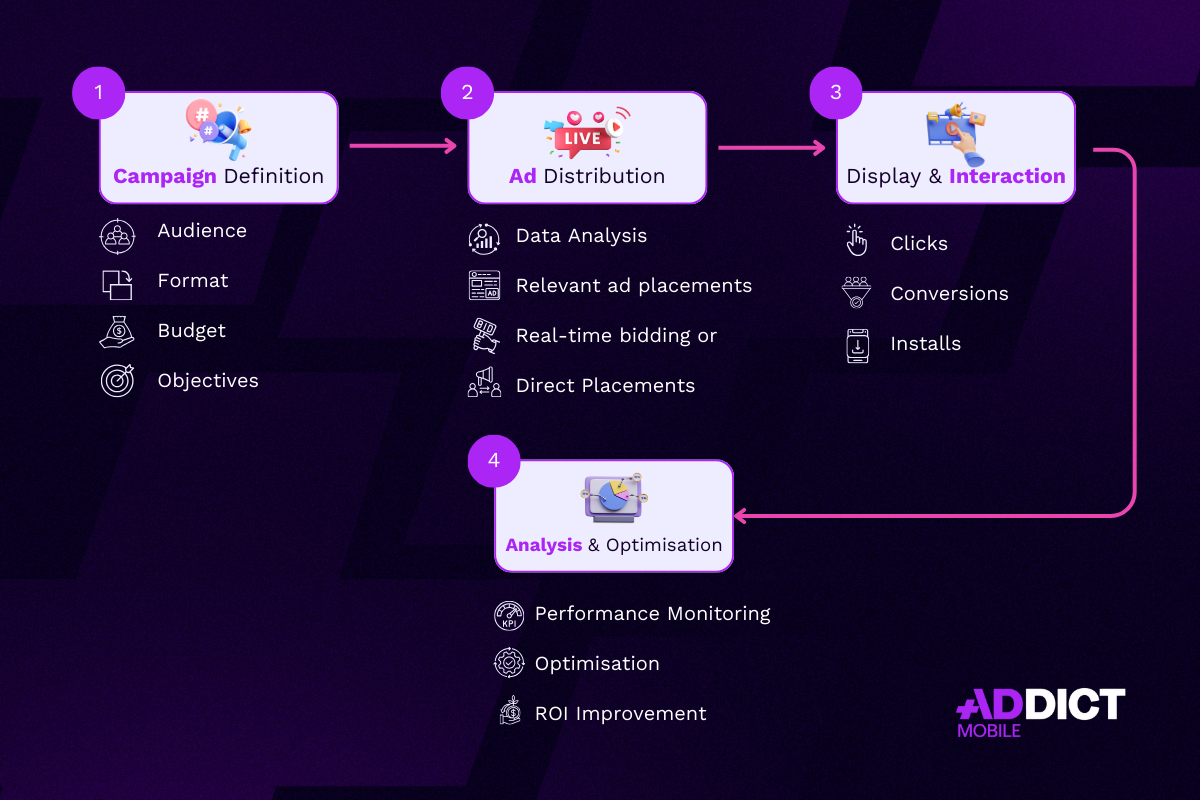Ad Networks: The Key to Success in Mobile UA | Complete Guide
Introduction
With thousands of apps being launched daily, advertisers need a strategic approach to stand out. This is where ad networks come into play. But what advantages do they offer for mobile campaigns? And how can advertisers ensure optimal performance? Let’s break it down.
What Is an Ad Network?
An ad network is a platform that connects advertisers looking to promote their ads with publishers who have available ad spaces on their websites or apps. These networks optimize ad delivery based on advertiser-defined criteria, ensuring effective targeting and maximizing performance. There are different types of ad networks, from broad-based platforms like Google Display Network and Meta Ads to specialized networks such as Unity Ads, offering a wide range of solutions for marketing strategies.
How Does an Ad Network Work?
Ad networks operate through a multi-step process:
- Campaign Setup: Advertisers define their target audience, ad format (banner, video, interstitial, native ad), budget, and objectives.
- Ad Delivery: The network analyzes data and places the ad in the most relevant spaces, either through real-time bidding (RTB) or direct placements.
- Ad Display & Interaction: Users see the ad and may interact with it (clicks, conversions, app installs, etc.).
- Performance Analysis & Optimization: The campaign’s performance is monitored, and adjustments are made to improve return on investment (ROI).

Key Benefits: Diversification & Continuous Optimization
Leveraging ad networks provides several significant advantages when launching UA campaigns for apps:
1. Access to Diverse and Targeted Audiences
Ad networks enable advertisers to reach a variety of audiences through partnerships with numerous apps and websites. In mobile UA, this means targeting users based on geolocation, app preferences, or even purchase behavior.
2. Variety of Ad Formats
From rewarded video ads to native ads, networks offer multiple formats suited to different marketing objectives. This variety helps capture user attention and increase conversion rates.
3. Cost Optimization
Ad networks often operate on models like CPM (cost per thousand impressions) or CPA (cost per action), allowing advertisers to manage budgets efficiently. With advanced tools, campaigns can be adjusted in real time to maximize ROI.
4. Advanced Analytics and Optimization Tools
Leading ad networks provide comprehensive dashboards for real-time performance tracking. Advertisers can identify high-performing creatives, top placements, and refine strategies accordingly. Many networks also incorporate machine learning algorithms to maximize performance levels.
Best Practices for Maximizing Performance on Ad Networks
1. Choosing the Right Ad Network
Each network has its specialties. Google Ads and Facebook Audience Network are great for large-scale targeting, while networks like Moloco and AppLovin specialize in mobile campaigns with advanced algorithms. It’s essential to align your choice with your objectives.
By Geographic Region
Some advertising networks perform better in particular regions. For Instance :
- Google Ads: Global coverage, ideal for international audiences.
- TikTok For Business: Best suited for campaigns in Asia, particularly China.
- Moloco: Recognized for strong performance in North America and Europe.
By Audience Type
- Facebook Audience Network: Ideal for reaching established and engaged social media users.
- InMobi: Well-known for targeting influential audiences (fashion lovers, food enthusiasts, students, fitness aficionados, etc.).
- AppLovin or Unity Ads: Best for reaching active mobile gamers.
- Snapchat Ads: Perfect for a young, tech-savvy audience.
By Ad Format
- Rewarded Video: Use Unity Ads or IronSource for in-game ad formats.
- Native Ads: Google Ads and Taboola provide solid options for seamless integration.
- Immersive Formats: Snap Ads and TikTok stand out with interactive and engaging formats.
By Campaign Objective
- Mass User Acquisition: Google Ads, Facebook, and TikTok are the best for reaching a broad audience.
- Engagement and High-Quality Conversions: Moloco and AppLovin optimize bidding based on post-install conversions.
- Retargeting: Criteo and AdRoll excel in re-engaging existing users.
2. Creating Effective Ad Creatives
Ad creatives play a crucial role in user engagement. Use tools like CreaThor to generate multiple creative variations, test them, and optimize based on performance.
3. Utilizing A/B Testing
Optimize results by testing different campaign elements, including headlines, visuals, CTAs (calls to action), and formats. A/B testing helps identify what resonates best with your target audience.
4. Continuous Data Analysis
Data collection and analysis are essential for refining campaigns. Key performance indicators (KPIs) such as CPI (cost per install), retention rate, and post-install conversions should be closely monitored to adjust strategies.
5. Leveraging Personalization
Users respond better to tailored messages. Segment audiences and personalize campaigns based on their preferences, habits, or location.
6. Collaborating with Ad Network Teams
Tap into the expertise of ad network teams for recommendations. They can provide benchmarks, best practices, and suggestions to maximize your campaign performance.

Do not hesitate to contact with our teams
Addict can support you to improve your performance.
Ad Networks: A Must-Have for Mobile UA
In conclusion, ad networks are invaluable allies in mobile acquisition campaigns. They provide unique access to precise audiences, advanced optimization tools, and a variety of creative formats. However, to fully leverage their potential, a strategic, data-driven approach is essential.
By applying the best practices outlined above, you can maximize your chances of success and efficiently achieve your user acquisition goals.


